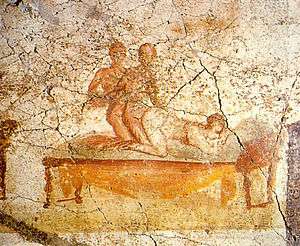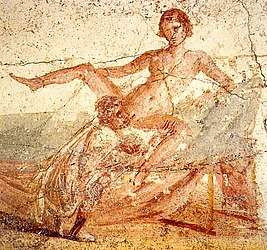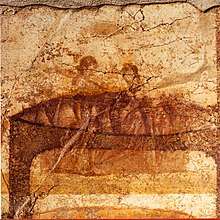Suburban Baths (Pompeii)
The Suburban Baths[1] (Italian Terme Suburbane[2]) are a building in Pompeii, Italy, a town in the Italian region of Campania that was buried by the eruption of Mount Vesuvius in 79 AD, which consequently preserved it.[3]
.jpg)
The Suburban Baths were publicly owned, as were also the Stabian, Forum, and Central baths in the city.[4] They were built in the early empire, possibly under the Emperor Tiberius (14–37 AD),[5] much later than the others and thus were located outside the walls where land was more easily available; by this time the walls had lost their defensive role.[6][7]
The baths also benefitted from the increased supply of running water after the connection of the city to the Aqua Augusta aqueduct in 30–20 BC.[7][8][9]
The bathhouse was renovated after the earthquake of 62 AD, in which a piscina calida, a heated swimming pool, was added to the north of the complex.[10][11][12]
They were originally discovered in 1958, much later than the rest of the city, though a systematic excavation had to wait until 1985–1987, which gave us valuable new insights into aspects of social and cultural workings of Roman life in Pompeii.[10][13][14]
Although publicly owned, these baths seem to have been reserved for a private clientele unlike the other public baths.[15]
The building is notable for its surviving erotic wall paintings, the only set of such art found in a public Roman bath house.
Structure
The building was a two-storey structure: the upper floor, as in the Palaestra/Sarno baths, was subdivided into three apartments for rent, with views towards the port and the Bay of Naples through the large glass windows.[7][4][12][16] These rooms may also have provided space for the selling of sexual services.[16][17] This upper floor was either accessed by a staircase from the floor below or via a door on the Via Marina.[7][4][12][16]
The baths were built to a higher standard of luxury and thermal effectiveness than the earlier baths in the town and have many hallmarks of the “newer” bath architecture of the 1st century AD: "single-axis row" type (with rooms in a linear increasingly warm arrangement promoting a particular route through the baths and bordering a palaestra)[4][10] , large windows facing southwest, and an outdoor pool with a fountain.
Construction was first limited to the apodyterium (dressing room), frigidarium (cold room), tepidarium (warm room), laconicum and calidarium (hot room); the natatio was added later as three rooms, including a nymphaeum with a water cascade,[8][18] providing an alternative route to the existing one of the tepidarium followed by the calidarium.[19] The entrance to the bathhouse is through a long corridor that leads into the apodyterium. The bathers would also have had access to a latrine, seating between six and eight people.[20]
Only one apodyterium has led to speculation by archaeologists that both men and women shared this facility, or that it was male-only or time-shared. The apodyterium contains the erotic wall paintings.
Erotic art in the Suburban Baths
The erotic wall paintings in the Suburban Baths are the only set of such art found in a public Roman bath house. Explicit sex scenes (such as group sex and oral sex) are depicted in these paintings that cannot be easily found in collections of erotic Roman art. As the sexual acts portrayed are all considered "debased" according to the customs of ancient Rome, it is possible that the intention behind their reproduction was to provide a source of humour to visitors of the building.[21] The paintings are located in the apodyterium and each scene is located above a numbered box. These boxes are thought to have functioned as lockers in which bathers put their clothes. It is speculated that the paintings possibly served as way for the bathers to remember the location of their box (in lieu of numbering).[16][22] The presence of these paintings in a public bathhouse shared by men and women gives some insight into Roman culture and suggests that people would not have found this offensive, and possibly humorous.[21]
The images are as follows:
- two images showing generic male-female coital scenes
- woman performing fellatio on a man
- man performing cunnilingus on a woman
- one lesbian duo with a phallus-shaped sexual aid or dildo
- one threesome
- one foursome
- naked man with deformed, huge testicles
 Fresco from the Suburban baths of a 2 male and 1 female threesome.
Fresco from the Suburban baths of a 2 male and 1 female threesome. Fresco from the Suburban baths depicting cunnilingus.
Fresco from the Suburban baths depicting cunnilingus. Fresco from the Suburban baths in cowgirl position
Fresco from the Suburban baths in cowgirl position Part of the famous mural showing variants of sexual intercourse. Roman fresco from the Terme Suburbane in Pompeii.
Part of the famous mural showing variants of sexual intercourse. Roman fresco from the Terme Suburbane in Pompeii. Scene V of the famous mural showing variants of sexual intercourse. Couple in bed. The hair of the figure on the left indicates that this is a lesbian sex scene. The woman on the right wearing a fascia pectoralis lies back on a bed or a cline. The patches of dark green color are remains of the repainting of the wall.
Scene V of the famous mural showing variants of sexual intercourse. Couple in bed. The hair of the figure on the left indicates that this is a lesbian sex scene. The woman on the right wearing a fascia pectoralis lies back on a bed or a cline. The patches of dark green color are remains of the repainting of the wall.
Sources
- Berry, J. (2007) The Complete Pompeii, London: Thames & Hudson Ltd. ISBN 9780500290927
- Fagan, G. G. (1999) Bathing in Public in the Roman World, United States of America: The University of Michigan Press. ISBN 9780472088652
- Garret G. Fagan, "The Genesis of the Roman Public Bath: Recent Approaches and Future Directions", American Journal of Archaeology, Vol. 105, No. 3. (July 2001), pp. 403–426.
- Jacobelli (1995). Le pitture erotiche delle Terme Suburbane di Pompei. Rome: 'L'Erma' di Bretschneider. ISBN 9788870628807. (See review by John R. Clarke's in: The American Journal of Archaeology, Vol. 100, No. 2 (April 1996), pp. 431–432.)
- Koloski-Ostrow, A. O. (2007) ‘The city baths of Pompeii and Herculaneum’, in The World of Pompeii, ed. by J. J. Dobbins and P. W. Foss (Abingdon: Routledge), pp. 224–256. ISBN 9780415475778
- Roger Ling, Review: "Le pitture erotiche delle Terma Suburbane de Pompeii" by L. Jacobelli, The Classical Review, New Ser., Vol. 46, No. 2 (1996), pp. 390–391.
- Ling, R. (2011) Pompeii: History, Life and Afterlife, Stroud: The History Press. ISBN 9780752414591
- Manderscheid, H. (2000) ‘The Water Management of Greek and Roman Baths’, in Handbook of Ancient Water Technology, ed. by O. Wikander (Leiden: Brill), pp. 467–538. ISBN 9789004111233
- Inge Nielsen (1990). The Architecture and Cultural History of Roman Public Baths, Aarhus University Press. ISBN 9788772885124
- Roy Bowen Ward, "Women in Roman Baths", The Harvard Theological Review, Vol. 85, No. 2. (April 1992), pp. 125–147.
References
- "Suburban Baths – AD79eruption". sites.google.com. Retrieved 2020-01-26.
- "Pleiades Gazetteer: "Suburban Baths (973204925)". pleiades.stoa.org. Retrieved 2020-01-30.
- David Fredrick (3 October 2002). The Roman Gaze: Vision, Power, and the Body. JHU Press. pp. 152–. ISBN 978-0-8018-6961-7.
- Koloski-Ostrow, A. O. (2007). "The City Baths of Pompeii and Herculaneum". In Dobbins, J. J. (ed.). The World Of Pompeii. Abingdon: Routledge. pp. 224.
- L.Jacobelli,"Lo scavo delle Terme Suburbane. Notizie preliminari," Rivista di studi pompeiani, 1987, vol. 1, pp. 151–4
- Ling, R. (2011). Pompeii: History, Life and Afterlife. Stroud: The History Press. p. 130.
- Berry, J. (2007). The Complete Pompeii. London: Thames & Hudson Ltd. pp. 152.
- Manderscheid, H. (2000). "The Water Management of Greek and Roman Baths". In Wikander, O. (ed.). The Handbook of Ancient Water Technology. Leiden: Brill. pp. 526–528.
- Ling, R. (2011). Pompeii: History, Life, and Afterlife. Stroud: The History Press. p. 72.
- Fagan, G. G. (1999). Bathing in Public in the Roman World. United States of America: University of Michigan Press. pp. 64–65.
- Berry, J. (2007). The Complete Pompeii. London: Thames & Hudson Ltd. pp. 238.
- Nielsen, I. (1990). Thermae et Balnea: The Architecture and Cultural History of Roman Public baths. Aarhus: Aarhus University Press. pp. 47–48.
- Dobbins, John; Foss, Pedar (2007). The World of Pompeii. New York: Routledge: Taylor and Francis Group. p. 241
- Alison E. Cooley; M. G. L. Cooley (1 October 2013). Pompeii and Herculaneum: A Sourcebook. Routledge. pp. 60–. ISBN 978-1-134-62449-2.
- H. Jacobelli, “Die Suburbanen Thermen in Pompei: Architektur, Raumfunktion und Ausstattung,” Archaeologisches Korrespondenzblatt, 1993, vol. 23, pp. 327–35; J. DeLaine and D. E. Johnston (eds), Roman Baths and Bathing. Part 2. Design and Context, JRA Suppl. Ser. no. 37.2, 2000.
- Beard, M. (2010). Pompeii. London: Profile Books Ltd. pp. 248–250.
- Fagan, G. G. (1999). Bathing in Public in the Roman World. United States of America: The University of Michigan Press. p. 36.
- Jones, R.; Robinson, D. (2005). "Water, Wealth, and Social Status in Pompeii: The House of the Vestals in the First Century". American Journal of Archaeology. 109: 696.
- Luciana Jacobelli, The erotic paintings of the Suburban Baths of Pompeii , Rome, L'Erma di Bretschneider, 1995. ISBN 88-7062-880-9 p. 13
- Koloski-Ostrow, A. O. (2010). The Archaeology of Sanitation in Roman Italy: Toilets, Sewers, and Water Systems. United States of America: The University of North Carolina Press. p. 10.
- John R. Clarke (2014). "Chapter 31: Sexuality and Visual Representation". In Thomas K. Hubbard (ed.). A Companion to Greek and Roman Sexualities. Blackwell Publishing Ltd. pp. 509–533. ISBN 978-1-4051-9572-0.
- Berry, J. (2007). The Complete Pompeii. London: Thames & Hudson Ltd. pp. 109.